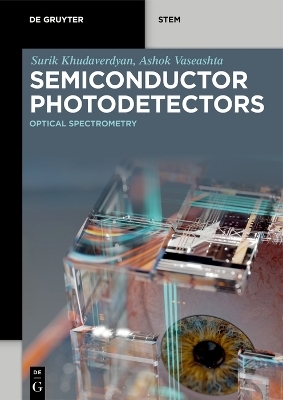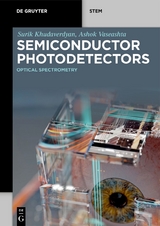Semiconductor Photodetectors
Prof. Surik Khaudaverdyan was born in 1952 in Georgia. He graduated from Polytechnic Institute in Yerevan, and graduate school in Moscow. He worked in NA ASSR, as a junior researcher in charge of the department. 1981 PhD, 2005 DSc. 1987 NPUA Assistant Professor, 2007 Prof. 2006 - head of the department, since 2011 - head of the science laboratory. Member of the council for the thesis jury and the editorial board of the journal ITERE. Managed international and national scientific projects. Received commemorative medal award from the Prime Minister of RA, the gold medal of NPUA. He was selected for the Laureate of the RA President's Award. He is the author/editor of 4 books and has published over 130 articles in scientific journals, book chapters, and conferences.
Prof. Ashok Vaseashta is a researcher and Executive director of research with the International Clean Water Institute in Virginia, USA. He received a Ph.D. from the Virginia Polytechnic Institute and State University, Blacksburg, VA in 1990 followed by Kobe's post-doctoral fellowship. He has served as a Professor at Virginia Tech and Marshall University. His honorary appointments include being a professor at the Transylvania University of Brasov; Chaired Professor of Nanotechnology at the Ghitu Institute of Electrical Engineering and Nanotechnologies, Honorary member of the Academy of Sciences of Moldova; Academician at the Euro-Mediterranean Academy of Arts and Sciences, member of CIRET, France, and Senior Strategic Research Advisor for several organizations. Inspired by nature and guided by societal necessities, he strives for technological innovations to address the global challenges of the 21st century. His research interests span nanotechnology, environmental/ecological science, heuristics, and critical infrastructure safety and security. He is the author/editor of 14 books and has published over 350 articles in scientific journals, book chapters, and conferences. He serves on the editorial boards of several prestigious international journals and is an active member of various professional organizations.
The scientific monograph of co-authors Surik Khudaverdyan and Ashok Vaseashta entitled Semiconductor Photodetectors: Optical Spectrometry contains the results of multi-year research dedicated to the discovery of the photocurrent injection amplification mechanism in silicon and cadmium telluride samples in the optical (silicon and cadmium telluride) and X-ray ranges resistant to action (cadmium telluride) to the development of ultrasensitive devices. Special attention was paid to the photocurrent compensation processes generated in the opposing potential barriers covering the layer during the longitudinal absorption of the beam in the substrate. In silicon and cadmium telluride structures with opposing potential barriers, the phenomenon of spectral photocurrent sign change and the wavemetric possibilities provided by it, the short and long wavelength maxima of the spectral photocurrent and their unusually high photosensitivity were revealed for the first time. A new mechanism spectral analysis was used in the algorithm obtained by mathematical modeling of photoelectronic processes in structures. This allows for the development of photospectrometers that lack the diffraction gratings, prisms, photodetector arrays, and precise optical and mechanical devices found in traditional photospectrometers.
All of that was considered in the perspective of quantitative remote identification of components of optically transparent media and facing modern challenges.
I believe that the monograph is an important contribution to the field of semiconductor photodetectors, and it is necessary and useful for undergraduates, graduate students, and the scientific community in the field.
Prof. Dr. Hovik Bagdasaryan, National Polytechnic University of Armenia, Email: hovik@seua.am
-
Authored by Surik Khudaverdyan and Ashok Vaseashta, the scientific monograph titled "Semiconductor Photodetectors, Optical Spectrometry" is dedicated to the development and research of photosensors with advanced functional capabilities designed to address modern challenges. The authors have successfully developed silicon photosensors based on a novel physical principle for photocurrent processing, allowing spectrometric properties to be achieved through an innovative algorithm. This type of photosensor eliminates the need for optical-mechanical systems while ensuring high resolution and reliable spectrum registration.
The authors have also developed photosensors based on cadmium tellurite and silicon that enable photocurrent injection amplification in both the visible and X-ray spectrums. These structures exhibit very low dark currents, which ensures high photosensitivity and the capability to detect weak signals.
The findings presented in the monograph hold significant potential for remote spectral analysis of harmful substances, enabling their identification and quantitative telemetry. This includes assessing the impact of these substances on humans, animals, vegetation, air, water, and food sources, as well as identifying and mitigating pollution sources.
I am confident that the authors' innovations will contribute valuable tools to address the environmental, biological, healthcare, and other pressing challenges facing humanity.
This scientific monograph contains numerous advancements in semiconductor photonics and is a valuable resource for students, postgraduates, and the broader scientific community within this field.
Prof. Dr. Karen Hambaryan, Yerevan State University, Armenia, Email: kgambaryan@ysu.am
| Erscheinungsdatum | 05.09.2024 |
|---|---|
| Reihe/Serie | De Gruyter STEM |
| Zusatzinfo | 34 b/w and 110 col. ill., 2 b/w tbl. |
| Verlagsort | Berlin/Boston |
| Sprache | englisch |
| Maße | 170 x 240 mm |
| Gewicht | 332 g |
| Themenwelt | Naturwissenschaften ► Physik / Astronomie ► Optik |
| Technik | |
| Schlagworte | Environment. • Optik • Photonics • Photonik • sensors |
| ISBN-10 | 3-11-142787-0 / 3111427870 |
| ISBN-13 | 978-3-11-142787-4 / 9783111427874 |
| Zustand | Neuware |
| Haben Sie eine Frage zum Produkt? |
aus dem Bereich




